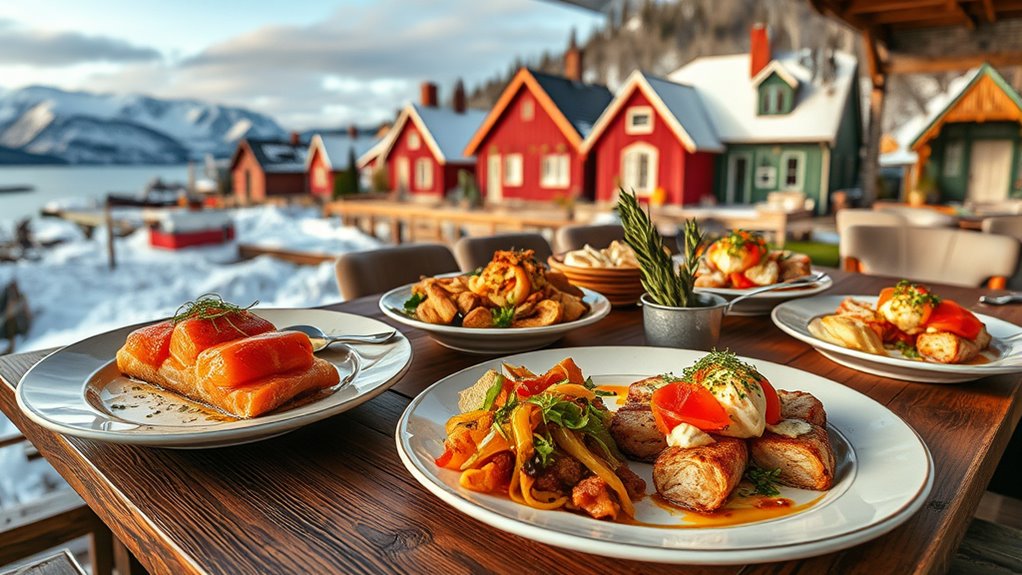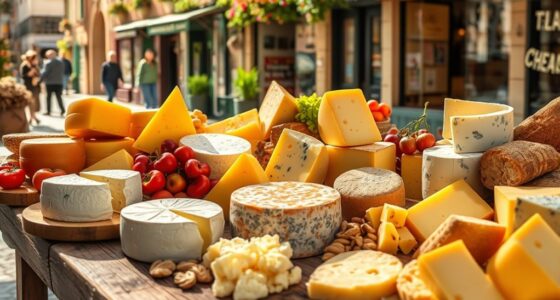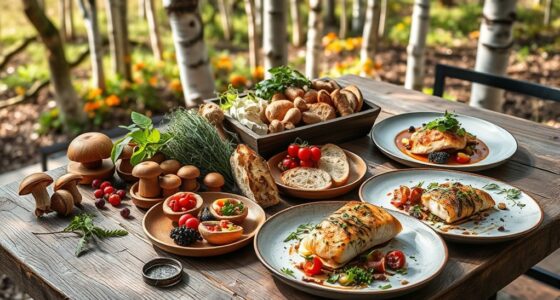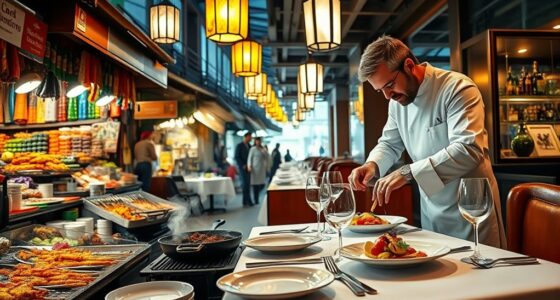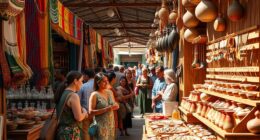Discover the vibrant Nordic cuisine trail from Copenhagen to Reykjavik, where innovative, sustainable practices meet traditional flavors. In Copenhagen, experience New Nordic techniques, minimalist plating, and eco-conscious innovations. In Stockholm and Oslo, savor local ingredients with regional sourcing and fresh seafood, while exploring historic eateries and modern fusion spots. Reykjavik offers marine delicacies, global influences, and eco-friendly dining. Continue exploring to uncover how each city blends tradition with innovation for a memorable culinary journey.
Key Takeaways
- Explore Copenhagen’s innovative Nordic restaurants like Noma, emphasizing fermentation, sustainability, and minimalist presentation.
- Discover Stockholm’s traditional and modern Nordic cuisine, focusing on local sourcing, fermented dishes, and open-fire techniques.
- Experience Reykjavik’s seafood-centric gastronomy, blending local ingredients with global techniques and sustainable fishing practices.
- Learn about Faroese traditional preservation methods like drying and fermenting, highlighting their cultural and sustainable significance.
- Join curated food tours connecting regional ingredients, culinary storytelling, and cultural insights across the Nordic countries.
Exploring Copenhagen’s New Nordic Cuisine Scene
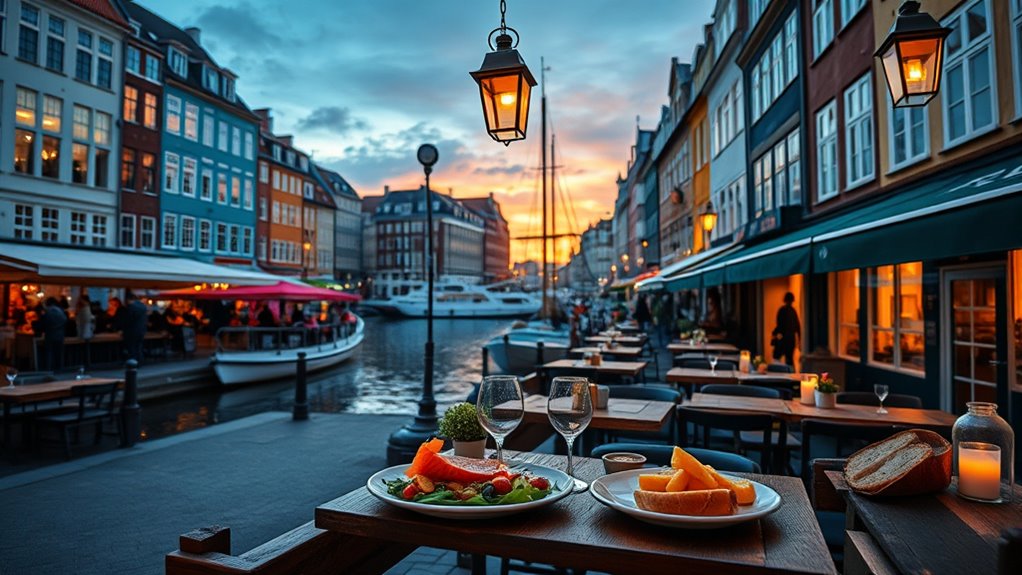
Copenhagen’s New Nordic cuisine scene has firmly established itself as a global culinary leader, drawing food enthusiasts from around the world. You’ll notice this in how chefs emphasize Nordic fermentation techniques, which deepen flavors and connect dishes to nature. The city’s top restaurants showcase minimalist plating, highlighting the purity and quality of local, seasonal ingredients. At places like Noma and Geranium, the focus isn’t just on taste but on artistic presentation that emphasizes simplicity and elegance. This approach reflects the movement’s core values—sustainability, terroir, and innovation. As you explore Copenhagen’s culinary landscape, you’ll experience how these techniques and aesthetic choices create a sensory journey that’s both sophisticated and rooted in Nordic traditions. Incorporating attention to detail into their practices ensures that every dish is crafted with precision, elevating the overall dining experience.
Culinary Gems in Stockholm and Oslo
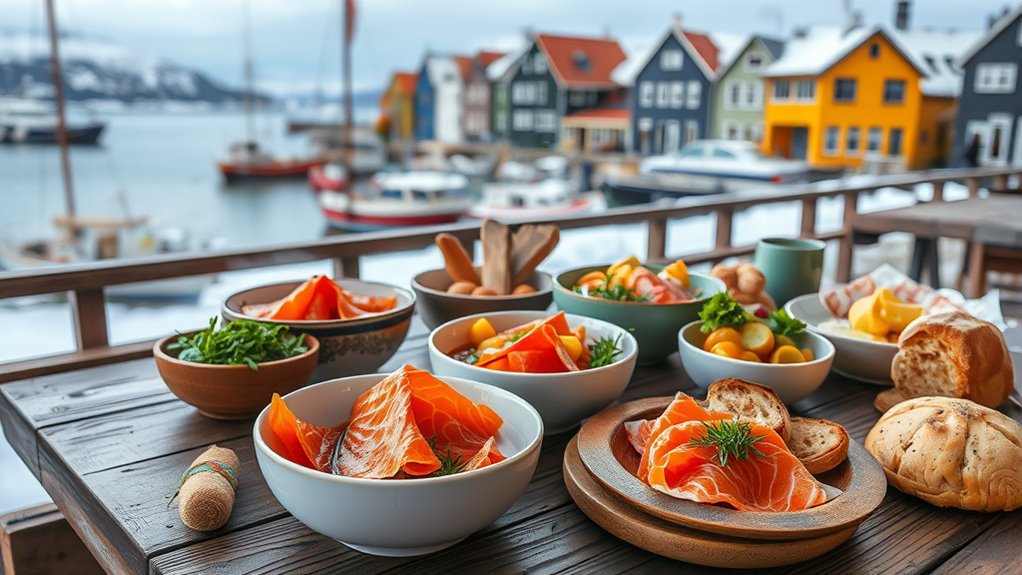
Stockholm and Oslo boast a vibrant culinary scene that seamlessly blends tradition with innovation. In Stockholm, you’ll find Swedish classics at Tennstopet, Riche, and Pelikan, where staff can guide you through authentic dishes like fermented herring and crayfish buffets. Modern Nordic cuisine shines at Frantzén and Ekstedt, emphasizing local, organic ingredients and open-fire techniques. Contemporary venues like TAK and Freyja fuse global flavors with Nordic raw materials, offering inventive dishes and Nordic desserts that delight the senses. Oslo’s culinary scene emphasizes fresh, seasonal Norwegian ingredients, from fjord fish to wild berries, often presented with modern flair. You’ll also discover traditional Scandinavian beverages and Nordic desserts like brunost and rakfisk, highlighting Norway’s sustainable, innovative approach to preserving its food culture. Stockholm’s historic restaurants, such as Pelikan and Kvarnen, are among the oldest in the country and are cherished for their authentic atmosphere and traditional recipes. Integrating email marketing strategies can further promote these culinary gems to a broader audience, showcasing their unique offerings effectively.
Savoring Reykjavik’s Seafood and Modern Gastronomy

Reykjavik’s seafood scene offers a feast of fresh catches like cod, langoustine, and even fermented shark, showcasing Iceland’s rich fishing heritage. Modern restaurants creatively blend traditional ingredients with global techniques, elevating the dining experience. Whether at a casual seaside shack or an upscale venue, you’ll find innovative dishes that highlight the city’s culinary ingenuity. The Best Seafood Restaurants in Reykjavik include renowned spots like The Sea Baron, Messinn, and The Fish Market, each offering unique interpretations of Icelandic marine delicacies. To enhance the dining experience, many establishments incorporate local ingredients and sustainable fishing practices.
Fresh Seafood Delights
Have you ever tasted seafood that captures the essence of a pristine, icy ocean? In Reykjavik, fresh seafood is a culinary cornerstone, showcasing local fish varieties and sustainable practices. You can enjoy:
- Signature dishes like lobster soup and grilled seasonal fish, highlighting Iceland’s catch-of-the-day.
- Traditional delicacies such as fermented shark and skate, offering bold Icelandic flavors.
- Shellfish and white fish prepared with modern techniques, elevating simple ingredients.
- Seafood venues like Sjavargrillid and Sea Baron, emphasizing local sourcing and freshness.
Restaurants prioritize seafood sustainability, ensuring the preservation of marine life while offering top-quality, locally sourced catches. This focus guarantees an authentic, eco-conscious culinary experience rooted in Reykjavik’s rich fishing heritage. Sustainable practices help maintain the health of Iceland’s marine ecosystems for future generations.
Innovative Culinary Scene
The city’s vibrant culinary scene pushes the boundaries of traditional Icelandic flavors by blending local ingredients with innovative techniques and global influences. Reykjavik’s modern gastronomy showcases culinary craftsmanship through Nordic fusion, elevating dishes with Icelandic lamb, cod, and wild herbs, often combined with international flavors from Thailand or India. Restaurants like Reykjavik Kitchen and Kol emphasize sustainability, sourcing locally and seasonally, supporting Icelandic farmers and fisheries. The ambiance enhances this creativity, from nautical-themed gastropubs to refined venues with lively atmospheres. This diversity offers a range of experiences, from iconic Icelandic classics to inventive fusion. The table below captures the essence of Reykjavik’s culinary innovation:
| Focus Area | Technique & Influence | Atmosphere & Experience |
|---|---|---|
| Nordic fusion | Global ingredients & modern methods | Vibrant, eclectic dining |
| Sustainability | Local sourcing & seasonal menus | Cozy, authentic ambiance |
| Culinary craftsmanship | Artful presentation & innovation | Unique, memorable settings |
| Regional flavors | Icelandic herbs & spirits | Inviting, immersive environment |
Reykjavik’s food scene is also distinguished by its commitment to sustainability, with many restaurants prioritizing eco-friendly practices and responsible sourcing to preserve Iceland’s natural resources. Additionally, the city’s emphasis on local ingredients ensures freshness and supports the region’s agricultural and fishing communities.
Traditional Flavors of the Faroe Islands
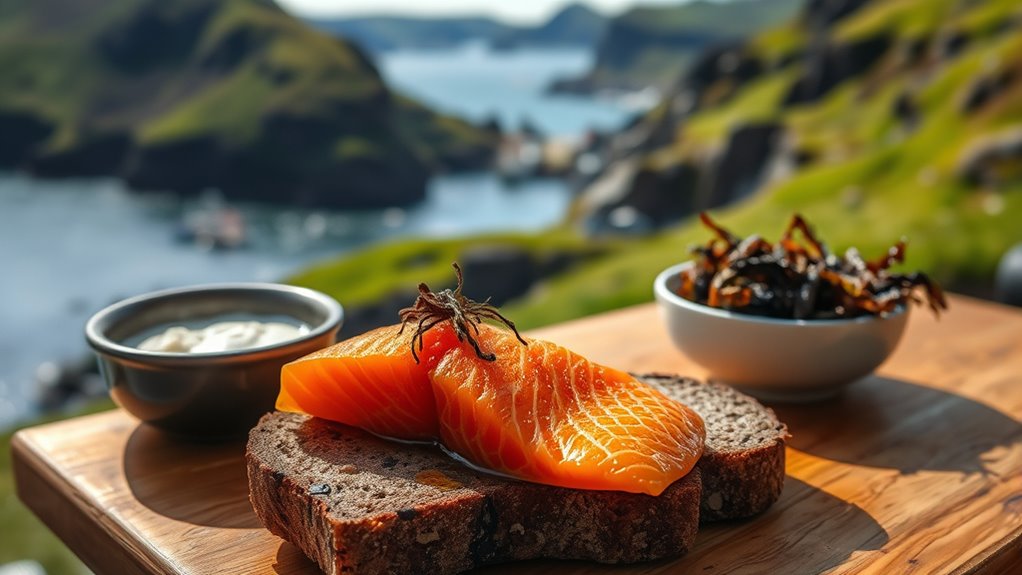
What makes the traditional flavors of the Faroe Islands so distinctive is their deep connection to the islands’ natural resources and harsh climate. You’ll find Faroese preservation techniques that define the cuisine, such as drying, fermenting, and smoking, which give dishes their intense flavors. Key ingredients include:
- Faroese preservation methods like skerpikjøt, an air-dried fermented lamb meat, and ræstur fiskur, fermented fish.
- Whale delicacies, where whale meat and blubber are cooked or dried, reflecting historic subsistence practices.
- Limited fresh vegetables, replaced by root vegetables like potatoes, turnips, and kohlrabi, grown slowly in tough conditions.
- Wild herbs and algae used for seasoning, adding regional authenticity.
- The use of antioxidants in local ingredients supports health and resilience in the challenging environment.
Sustainable Practices and Culinary Innovation in Scandinavia

You’ll see how Scandinavian chefs prioritize regional sourcing, emphasizing local, seasonal ingredients to reduce environmental impact. They blend traditional flavors with innovative techniques, creating dishes that are both sustainable and forward-thinking. This fusion of tradition and innovation highlights Scandinavia’s commitment to responsible culinary practices. Additionally, many chefs incorporate sustainable food innovations developed through Nordic research programs to further enhance their culinary offerings. Some of these innovations include wax-free candle techniques that reflect eco-conscious material choices, aligning with the region’s sustainable ethos.
Regional Sourcing and Sustainability
Regional sourcing and sustainability are shaping the future of Nordic cuisine by emphasizing local ingredients, transparent supply chains, and eco-friendly practices. You’ll notice a focus on urban farming initiatives that boost local food production and reduce food miles. To strengthen sustainable practices, Nordic countries are:
- Mapping value chains to identify obstacles for regional producers.
- Increasing transparency and accountability in procurement, especially in fish quotas and seasonal resources.
- Promoting food waste reduction by encouraging farmers and chefs to utilize imperfect produce and leftovers.
- Supporting local, seasonal ingredients through flexible sourcing strategies that adapt to weather and availability.
- Incorporating sustainable practices into culinary innovation to further enhance environmental resilience.
These efforts foster a resilient, eco-conscious culinary scene that prioritizes both environmental sustainability and community health, ensuring Nordic cuisine remains innovative and grounded in its regional roots.
Fusion of Tradition and Innovation
The Nordic culinary scene is rapidly evolving by blending time-honored traditions with forward-thinking innovation, creating exciting new flavors and experiences. You’ll notice a farm-to-table approach, emphasizing local ingredients that tell a story of place. Chefs fuse global flavors like miso, chili oil, and furikake into traditional Nordic dishes, resulting in innovative creations such as miso pasta or banh mi tacos. Quick, umami-rich sauces become staples, speeding up meal prep without sacrificing taste. Snacking takes on culinary creativity with healthy options like hummus bars and topped egg halves, starting in restaurants and moving into retail. This movement embraces imperfection, authenticity, and sustainable practices, reflecting a commitment to environmental goals and cultural storytelling.
| Traditional Foods | Innovative Flavors |
|---|---|
| Nordic fish dishes | Miso-infused pasta |
| Root vegetables | Banh mi tacos |
| Fermented foods | Tandoori pizza |
Guided Food Tours: Experiences Across the Nordic Capitals
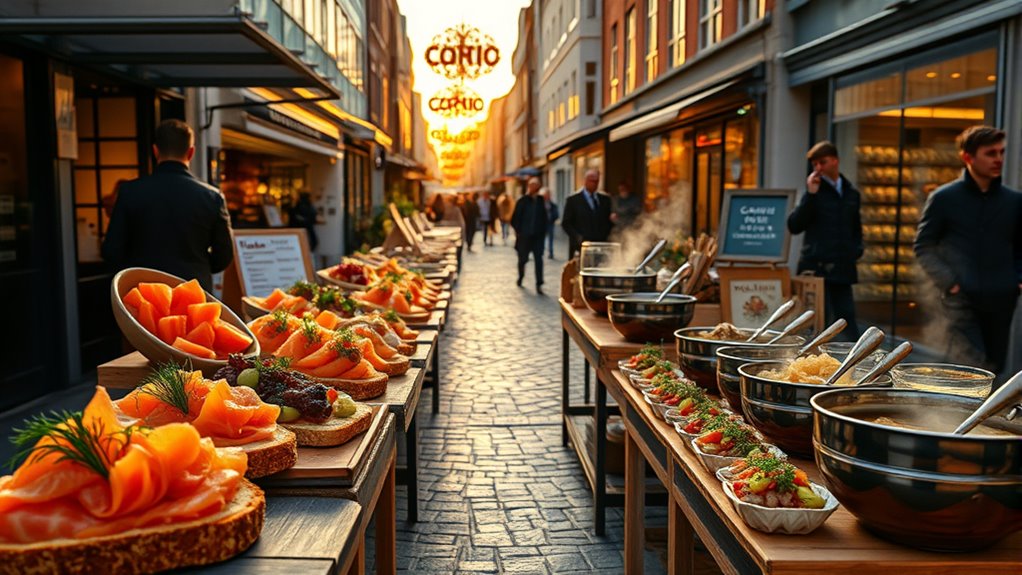
Curious about how culinary traditions come to life across the Nordic capitals? Guided food tours offer immersive experiences that highlight farm to table practices and rich culinary storytelling. In Copenhagen, expert guides lead you through exclusive venues like Michelin-level cheese shops and historic cafés, emphasizing sustainable and authentic ingredients. You’ll enjoy:
- Tasting iconic Danish foods such as smørrebrød, organic hot dogs, and handmade sweets
- Visiting local markets and bakeries that showcase Danish craftsmanship
- Learning stories behind food production, focusing on authenticity and tradition
- Exploring beyond tourist spots, connecting food with history and culture
Additionally, these tours often incorporate sound design elements to enhance the storytelling experience, making each visit more engaging and memorable.
Similarly, Stockholm, Oslo, and Reykjavik tours combine local flavors, innovative dishes, and cultural insights. These experiences deepen your appreciation for Nordic culinary heritage and sustainable sourcing.
Regional Ingredients and Cooking Techniques

Exploring Nordic cuisine means understanding how local ingredients and traditional techniques shape its distinct flavors. Berries like lingonberries and cloudberries are harvested in summer, then preserved frozen for year-round use. Seafood, especially salmon and other fish, undergoes traditional smoking to develop its signature smoky taste. You’ll also find game meats like lamb and elk, often cured or dried to withstand cold climates. Preservation methods are vital—pickling, brining, and smoking extend ingredients’ shelf life. These methods reflect the resourcefulness needed in Nordic food culture. Food preservation techniques not only ensure year-round availability but also deepen the cultural connection to seasonal cycles.
Combining Sightseeing With Tasting Adventures
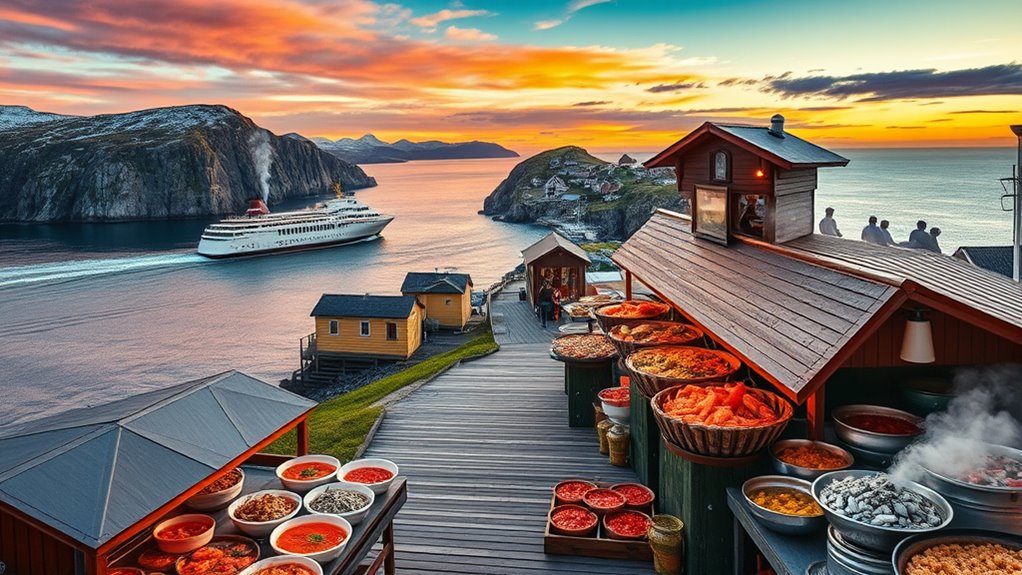
Combining sightseeing with tasting adventures transforms Nordic city tours into immersive cultural experiences. As you explore, you’ll enjoy more than just sights—you’ll savor local flavors through farm-to-table dishes and street food. Here are four ways this integration elevates your trip:
Enhance Nordic city tours with local flavors through farm-to-table eats and street food adventures.
- Visit historic markets offering seasonal ingredients, linking urban life with fresh, local produce.
- Sample street food vendors serving traditional snacks that reflect Nordic culinary heritage.
- Participate in culinary workshops that blend sightseeing at landmarks with hands-on cooking, emphasizing local recipes.
- Enjoy guided tours pairing iconic sites with exclusive tastings, like Danish smørrebrød or Icelandic seafood, creating sensory connections to the city’s history.
- Incorporate electric bike conversion kits to effortlessly explore the city’s culinary hotspots, ensuring a smooth and eco-friendly experience.
This approach deepens your understanding of Nordic culture, making each tour both educational and flavorful.
Frequently Asked Questions
How Do Nordic Food Tours Incorporate Local Sustainability Initiatives?
You see that Nordic food tours incorporate local sustainability initiatives by supporting sustainable fishing and organic farming. You’ll visit local fishermen and farmers practicing eco-friendly methods, learn traditional preservation techniques, and participate in foraging activities. These tours emphasize reducing food waste, using zero-waste cooking methods, and partnering with eco-friendly accommodations, ensuring your experience promotes environmental stewardship and community engagement while highlighting the region’s commitment to sustainability.
What Are the Best Seasons for Experiencing Traditional Nordic Ingredients?
Like the changing seasons in a Nordic saga, the best times to experience traditional ingredients are spring and summer. During spring, you’ll enjoy seasonal foraging of wild herbs, young greens, and early fish, revealing fresh regional flavor profiles. Summer offers a bounty of berries, seafood, and herbs, perfectly capturing local traditions. These seasons allow you to savor authentic flavors, rooted deeply in nature’s rhythm and regional culinary heritage.
How Do Culinary Styles Differ Between Urban and Rural Nordic Areas?
You’ll notice that urban Nordic culinary styles blend local ingredients with international influences, creating a sophisticated yet accessible cuisine. In contrast, rural areas focus on traditional culinary practices rooted in local ingredients, preserving ancestral recipes and terroir-based flavors. While urban chefs innovate and promote sustainability, rural communities emphasize preservation and simplicity. Both celebrate local ingredients, but urban areas lean toward modernization, and rural regions maintain deep ties to their culinary traditions.
Are There Specific Dietary Options Available on Nordic Food Tours?
Imagine you’re stepping into a Nordic food tour—like entering a vintage bakery with modern flavors. You’ll find vegan options and gluten-free choices, but they often need to be requested in advance. While vegetarian dishes are common, fully vegan or gluten-free meals might be limited due to traditional ingredients. To guarantee your dietary needs are met, communicate early with the tour operator, so they can tailor the experience to suit you.
How Do Historic Sites Enhance the Culinary Experience Across the Region?
You’ll find that historic sites like medieval castles and historic markets greatly enhance your culinary experience. These landmarks connect you to regional heritage, offering authentic settings that deepen your understanding of local traditions. Tasting foods in historic markets or dining near medieval castles allows you to appreciate the cultural roots behind each dish, making your culinary journey more immersive and memorable as you explore the region’s rich history through its flavors.
Conclusion
As you journey through Scandinavia’s culinary landscape, you’ll discover flavors as rich as Odin’s wisdom and as fresh as the Nordic winds. Each city offers a chapter in this delicious saga, blending tradition with innovation. Just like a well-crafted symphony, your taste buds will be enchanted, leaving you inspired to keep exploring. So, embrace the adventure—after all, every great story begins with a single bite.
